Darlington Tramways
History
Although Darlington's 3ft-gauge horse tramway opened for business on the 10th October 1880, it was actually not the first tramway in the town, that accolade going to the very early and short-lived Darlington Street Railway (1862 to 1864). The new tramway was, however, to have a much longer life, passing through four separate owners over the course of its 23-year existence, before its eventual conversion to electric traction.
At its maximum, the tramway extended to 2.13 miles, with lines from the Market Place running: southwards along Feethams, before turning eastwards along Victoria Rd to the North Eastern Railway's Bank Top Station; and northwards along Prebend Row and Northgate, where the line split, one route continuing northwards along Northgate and North Rd to St Paul's Church, and the other heading northwestwards along Bondgate and Woodland Rd to its junction with Carmel Rd at Cockerton, which was the borough boundary.
For the first 12 years or so of its existence, the tramway was owned and operated by the Stockton and Darlington Steam Tramways Company, which despite the inference, did not operate a unified system between the two towns, nor did it ever operate steam tram services in Darlington, which was always horse-drawn. The Darlington tramway was not a financial success, and in an attempt to stem the losses, the southern part of the system (to Bank Top Station) was closed in 1885. Despite this, the company continued to struggle, being under-capitalised, and therefore saddled with loan repayments and interest charges (primarily stemming from the Stockton steam lines) that it had no prospect of servicing. Things could clearly not continue as they were, and in June 1888, the S&DSTCo entered voluntary liquidation. The company was eventually restructured, emerging that same year under the guise of the Stockton and District Tramways Company, though still trading as the S&DSTCo.
By December 1895, the S&DTCo was once again in liquidation, with two badly run-down, and badly run systems, both making losses. The following year, the company was purchased by the grandly titled Imperial Tramways Company Ltd, which began life in 1878 — as a London-based company — with the purchase of several tramway systems (in places as diverse as Dublin and Reading) and which eventually had a railway interest too (the Corris Railway). In the 1890s, the ITCo developed plans for an electric system that would connect Middlesbrough, Stockton and Thornaby, and it was with this aim in mind that it purchased the S&DTCo, having owned the horse-drawn Middlesbrough and Stockton Tramways Company — which despite the name, only ever reached Newport, some two miles east of Stockton — since 1878.
The ITCo immediately set about improving the horse-tram services in Darlington, increasing their frequency such that they quickly returned a profit, a damning indictment if ever there was one of the managerial abilities of its predecessors. Although the ITCo obtained powers to rebuild and electrify the system, their plans were to come to naught, as it eventually became clear that Darlington Corporation were intent on building their own municipally operated system. As a result, the ITCo sold their Darlington assets to the corporation, the latter taking over ownership on the 24th January 1902. Given that the corporation were far from ready to reconstruct the system, its operation was leased to a Mr C J O'Dowd for the final 19 months of its life, the last horse tram running on the 18th August 1903.
Uniforms
The photographic record is reasonably rich for such a small system, and clearly shows that horse tram drivers and conductors wore heavy duty but informal attire, namely: trousers, jackets, shirts and ties, along with heavy overcoats in colder weather. Headgear tended to follow the fashion of the day, probably the bowler hat in the early years, and later on the flat cap. No badges of any description appear to have been worn on either the jackets or the hats. The odd photo shows conductors wearing a circular object on their cash-bag straps, suggestive of a licence, however, in view of its position, it is more than likely to have been a ticket punch.
Photographs of inspectors have not survived, so it is currently impossible to say whether men of this grade wore company uniforms or insignia, or indeed, whether the company even employed them at all.
Further reading
For a short history of Darlington's horse and electric tramways, see: 'The Light Railways of Darlington' by G S Hearse, in the Tramway Review No 11 (p49-58); Light Railway Transport League (1953).
Images
Horse Tram drivers and conductors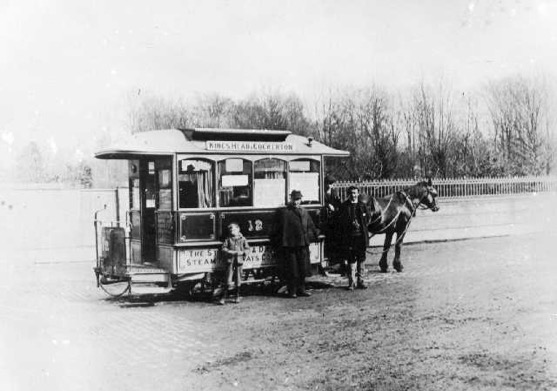
Tramcar No 12 and crew on a Kings Head to Cockerton service — photo undated, but definitely taken during Stockton and Darlington Steam Tramways Company days, probably in the mid-to-late 1880s. Photo courtesy of the Tramways and Light Railway Society, with thanks to David Voice.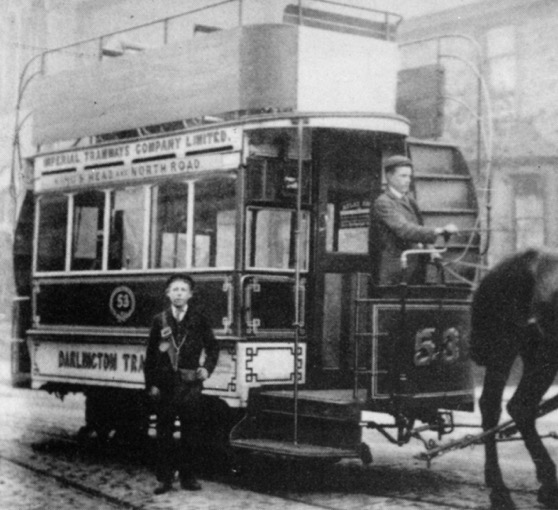
A very youthful conductor and his barely older driver, with Horse Tram No 53 in North Road — photo undated, but definitely taken during 'Imperial Tramways Company' ownership, and more than likely around the turn of the century. Why the tram has such a high number for a small system is something of a mystery — there was also a No 54 — though it may well be that this was actually a fleet number within the ITCo as a whole rather than Darlington itself. Photo courtesy of the Tramways and Light Railway Society, with thanks to David Voice.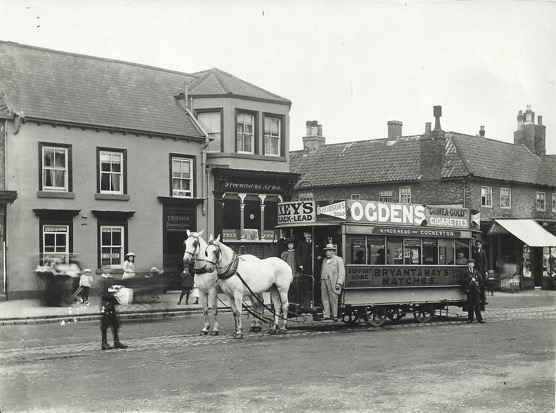
An unidentified horse tram in Bondgate — photo undated, but almost certainly taken between January 1902 and August 1903, when the system was municipally owned. Several photographs exist showing the same gentleman in the identical light-coloured suit (see below); he is in all probability, Mr C J O'Dowd, who operated the horse tramway on behalf of Darlington Corporation for the last 19 months of its existence. Photo by W Richardson, courtesy of the Stephen Howarth Collection.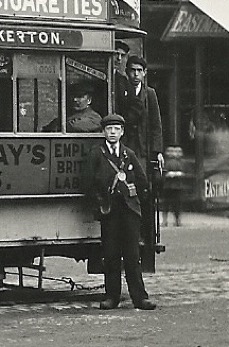
An enlargement of the above photograph showing the youthful conductor. He is clearly wearing informal attire, and what at first glance appears to be a round licence badge, though given its position, it is very probably a ticket punch.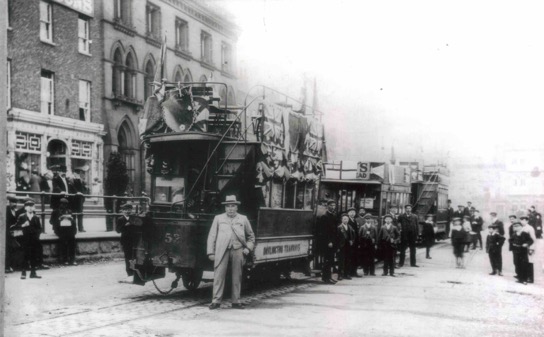
Mr C J O'Dowd again with a procession of three trams at the High Row terminus; photo undated, but possibly taken on the occasion of Edward VII's coronation (9th August 1902). Photo courtesy of the Stephen Lockwood Collection.
An enlargement of the above photograph showing the three extremely youthful conductors, only one of whom appears to have a round object (a ticket punch) on his cash-bag strap. Photo courtesy of the Stephen Lockwood Collection.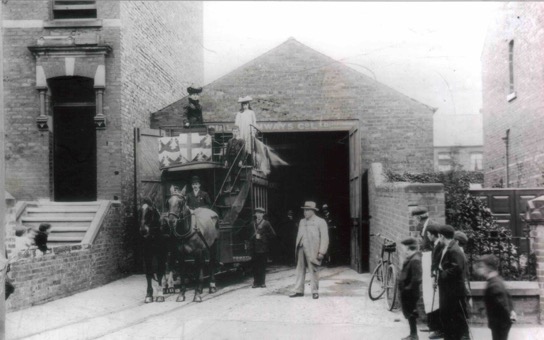
A driver, a conductor and the proprietor (presumably Mr C J O'Dowd) at Woodland Rd Depot on the 18th August 1903, the last day of operation. Photo courtesy of the Stephen Lockwood Collection.
A blow-up of the above photograph showing the smartly turned-out driver and conductor, neither of whom are wearing a licence badge.